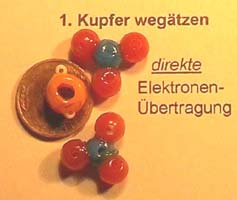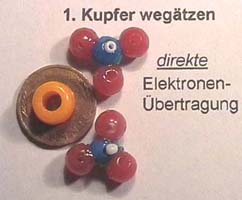 ....
.... ...
...
Photos 1.1 - 1.3
A Pfennig coin reacts with a drop of nitric acid releasing a brown gas + green-blue solution
1. Direct electron transfer from copper of a coin to nitrate ions
 ....
.... ...
...
The direct transfer of two
electrons from a copper atom to two nitrate ions is visualized by beads
of different sizes and colours. Middle: The orange bead with the
two micro beads is a model of a copper atom. The two blue beads each of
them welded with three red beads show a nitrate ion model.
Right: The models
ilustrate the result of the electron transfer (white micro beads) from
the copper atom to the nitrate ions.These two electron acceptors will immediately
continue reactions resulting in the nitrogen dioxide observed.
Reduction:
2 [NO3] -(aq) + 6e-
+ 8 H+(aq) --> 2 NO(g) + 4 H2O(l)
Oxidation:
3 Cu(s) ---> 3 Cu2+(aq) + 6 e-
Redox reaction: 3
Cu(s) + 2 [NO3]-(aq) + 8 H+(aq)
--> 3 Cu2+(aq) + 2 NO(g) + 4 H2O(l)